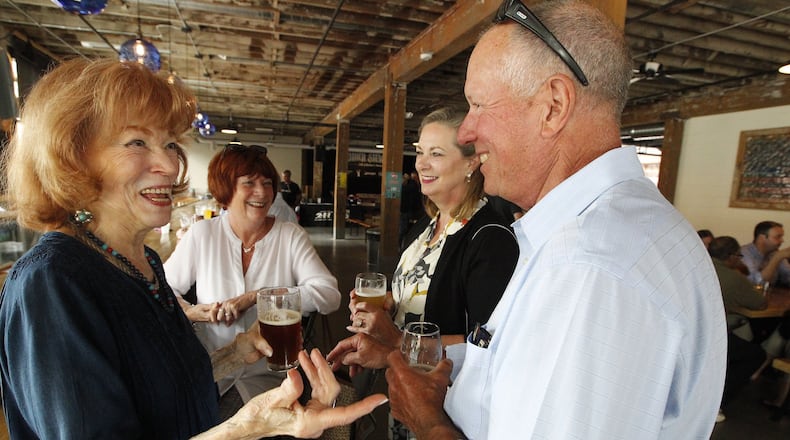The number of breweries in the region, including many in Columbus, Cincinnati and Dayton, have led to great Ohio-produced beers, Mother Stewart’s co-owner and Brewmaster Kevin Loftis said, but he’s not sure if its sustainable.
RELATED: Springfield brewery opens downtown
SOCIAL MEDIA: FOLLOW REPORTER MICHAEL COOPER ON FACEBOOK AND TWITTER.s
While off-site sales haven’t been as high as he would’ve hoped in its first year, the brewery has more than made up for it through sales at its taproom, 109 W. North St. He estimates it brewed between 600 and 700 barrels since it opened.
“It helps being the only one here (in Springfield),” Loftis said. “There’s a lot of great beer from Ohio that you can get anywhere you go. In that respect, it’s a good thing, but I don’t know if it’s sustainable or not.”
A new biennial economic impact study commissioned by the National Beer Wholesalers Association and the Beer Institute shows that industry growth exploded in recent years, contributing more than $13.2 billion to Ohio’s economy in 2016. That’s a $2 billion increase from 2015.
In 2011, the state was home to 32 craft breweries. Now at least 220 call Ohio home — a more than 580 percent increase in six years.
Justin Hemminger, spokesman for the Ohio Craft Brewers Association, said the boom in craft breweries directly correlates toward an overall market trend of eating and drinking local.
“Most of the people opening craft breweries right now, they realize it’s a good climate to try it and to try and sell beer, but they’re more concerned about making excellent beer versus it being a strict dollars-and-cents proposition,” Hemminger said.
The $2.5 million Springfield brewery opened last year after major renovations to a large brick building that once was part of the old Metallic Casket Co. campus.
The downtown Springfield brewery — called a “game changer” by downtown officials when it was first announced in 2015 — will celebrate its one-year anniversary at noon Sunday. The event begins at noon with yoga, followed by performances by The Harvesters from 1 to 3 p.m. and progressive bluegrass band Trout Steak Revival at 5 p.m.
“It’s good to have one year behind us and be well-received and embraced by the community,” Loftis said.
The big markets in the larger urban areas are quickly becoming crowded, he said, especially at bar taps and on regional shelf space — which has made outside sales more challenging than he expected.
RELATED: Proposed brewery may move location in downtown Springfield
“I don’t know how much more it can hold,” Loftis said. “You have a certain amount of people in the country that drink craft. It has gone up, but I’m not sure if it’s fast enough to sustain the explosive growth in the number of breweries. It is getting crowded, no doubt.”
The taproom has supported the business more than Loftis ever imagined, he said. About 90 percent of its sales are done on-site, he said, proving Springfield can support its own brewery.
“It’s been a pleasant surprise and frankly, the lifeline,” he said. “Our crew has done an awesome job.”
The popularity of the taproom forced the brewery to focus more on its on-site events, including multiple concert series, food trucks and festivals, such as an annual Oktoberfest. The outdoor biergarten has also allowed parents to bring their children, Loftis said.
The bar has brought in more people from across the region, he said, and Mother Stewart’s will host several tap takeovers in Columbus this month as it works to establish its brand there and in Dayton.
RELATED: Ohio may increase beer cap
The Ohio Craft Brewers Association counts 147 members out of the 220 operating craft breweries in the state. It also has more than 160 Allied Members in a wide variety of fields, including packaging, insurance, mechanical systems, architecture and farming.
“The local economy around the craft brewing industry has very long arms,” Hemminger said.
The same can be said for Mother Stewart’s, which purchases hops from New Carlisle’s Hop-Acre Farm and South Solon’s OSHY Hops, as well as malt from Davidson Family Growers in New Carlisle.
“It’s a neat aspect of craft beer, the growing aspect,” Loftis said.
MORE LOCAL STORIES: Read the latest news from Michael Cooper
The brewery has been a pioneer in the rebirth of downtown business, said Mike McDorman, CEO and president of the Chamber of Greater Springfield.
“Their success proves downtown is a viable option,” he said.
The next step in downtown Springfield’s development is market-rate housing, McDorman said.
“Their success helps attract developers that might take a risk on downtown where before they wouldn’t … It’s been amazing to watch them take an old building and make it new again. It will be catalytic in what we’re going to see in the next year.”
The brewery will focus on off-site sales in its second year and provide more programming at its taproom, he said. It may also introduce a food component to allow it to sell wine.
They will also be adding new beers, Loftis said.
“I’m going to get a little crazier than I have been,” he said. “It’s been good to get this year under my belt.”
3 QUICK MUST READ STORIES
Drug epidemic wreaking havoc on Clark County businesses, economy
Springfield backs $24M hazardous dump cleanup near water source
Springfield to restore cuts to $2.68M court budget after court order
By the numbers
$2.5 million: Estimated cost of the downtown brewery project.
$1.3 million: Estimated cost of improvements to be made at 109 W. North St.
600-700: Estimated barrels brewed by Mother Stewart's in its first year.
Staying with the story
The Springfield News-Sun was first to report on the plans for a downtown microbrewery in 2015 and will continue to track business developments in downtown.

